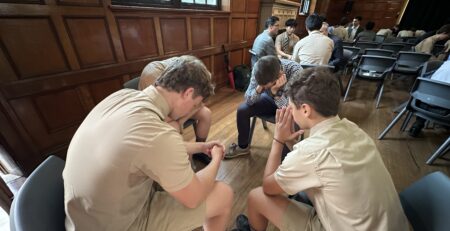The essence – and benefit – of community
I am firmly convinced of the primacy and power of the community in which education takes place. Both academic outcomes and the broader shaping of character are affected by the school community in which students are immersed. So, too, is the mental health of the students.
During the week I read an article online by Seth Kaplan which looks ‘upstream’ to understand the various causes of the youth mental health crisis. Kaplan argues that the loss of strong, in-person, local communities is a significant cause of this issue and, conversely, that strong, in-person, local communities are a significant protective factor. I commend the piece to you, as well as the broader website on which it is published, which is associated with Jonathan Haidt’s The Anxious Generation.
In the course of his essay, Kaplan describes the key features of a ‘community’, as it has been traditionally understood. The following list is extracted from his essay.
- A web of overlapping, affect-laden associations and relationships that crisscross and reinforce each other;
- A set of shared values, norms, and goals—a common culture that unifies and constrains;
- A common identity, ideally based on a common history and narrative and recognition of mutual interdependence;
- Shared rituals that celebrate the group, its past, and future;
- High levels of trust;
- High levels of commitment, with limited options for (or high costs to) exit;
- Recognition of and respect for common authority figures who guide the group’s decision-making;
- Keystone actors and institutions that bridge and bond different members together;
- A diverse range of skills and personalities that can contribute complementary things of value (e.g., money, time, expertise) to the group;
- Role models who exhibit the cultural behaviors that the group should ideally replicate or at least aspire to;
- Exhibiting a high degree of inclusiveness by actively seeking to encompass every member who shares the same identity or location;
- Capacity to strongly encourage through moral suasion certain norms of conduct and, if necessary, sanction misconduct.
In reading this list, I was struck with a strong sense of recognition. At each point, it seems to me that he could be describing our School, and others like it. Each day at Trinity, boys (and adults) experience this sort of community. We don’t necessarily draw their attention to it or put it in words, but it is their lived experience.
In years gone past, such a description might have applied to a locality, like a village or town. Perhaps it might apply to a particularly close-knit sporting club. However, I suspect that most of us would see its most direct manifestation at this stage in modern Australian history as being the school community.
The point I want to make is that immersion in the School community, with all its relationships, activities, traditions and norms, is potentially a protective factor for the mental health of our boys. Not that it is a fail-proof guarantee of good mental health, but that it is a good thing that helps them to go well on their journey through childhood and adolescence.
Tim Bowden | Headmaster
















